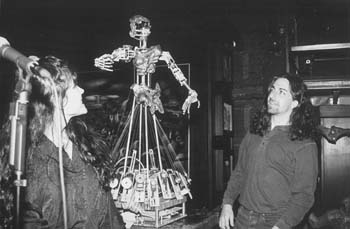![[MetroActive CyberScape]](/cyber/gifs/cyber468.gif)
![[MetroActive CyberScape]](/cyber/gifs/cyber468.gif)
[ CyberScape | Metro | MetroActive Central | Archives ]
Mechanical Animals
 Matt Ipcar It's Alive: Slave Zero, a 2-foot-high robot made by Carl Pisaturo that looks like it's wearing a hoop skirt, does an impossibly graceful stationary ballet. Omnicircus's robotic red light district By Michelle Goldberg On the stage of the Omnicircus, surrounded by robots, oil paintings and sculptures of contorted, tortured bodies, an old woman in a plaid shirt is playing a saw with a violin bow while using a foot pedal to make a wooden cat in a tutu dance. In front of her is a massive triangular bone that looks like it could have come from a dinosaur's knee. The sound of a saw, surprisingly, is quite lovely, piercing, nasal and vibrating all at once. She finishes her set with a rendition of "I Ain't Got Nobody." Following her is a magician who does a few desultory tricks before making way for the night's most fascinating performers, a group of robots that dance, fight and even beg for change. The event is a party for the release of a Swing CD by Omnicircus director Frank Garvey's father's band, the John Garvey Illinois All-Stars. Frank Garvey is a painter, musician, mechanical sculptor and fierce radical. He has an unnerving, intense presence, staring right through you as he makes enigmatic pronouncements like "I was always more comfortable in round houses than square ones, and that's the bottom line." To Garvey, robotic sculpture represents "an evolutionary leap." A committed progressive, he says that the world is suffering through the last days of what he calls "slave culture," a world in which people, instead of machines, are forced to labor for the benefit of the upper classes. "It's amazing to me that leftists fight for the right to have a job," he says. "Liberation now is more and more about having free time, the right to not to have a job without sacrificing your standard of living." The robots at Omnicircus were created by Garvey, Jeff Weber, Carl Pisaturo and Aaron Edsinger. Frightening creatures with knifes and blades jutting from their limbs and material that looks like charred skin hanging from their metal skeletons, the robots are an expression of the transition between our dying era and the future. Garvey calls Omnicircus a robotic red-light district, full of mechanical whores, junkies, brawlers and beggars. He turns on GoBoy, a menacing robotic panhandler in a wheelchair who spins jerkily around the room barking "I'm just like you! Gimme fifty cent!" After GoBoy has made his rounds, Garvey takes the stage with his band, DuesMachina. The group's music is eerie, grandiose and operatic, full of mournful synthesizers and piano, droning guitars and melodies, and vibrations from a host of obscure instruments that are strewn about Omnicircus's black-box stage. Singer Erin Kupferman's voice is rich, deep and, like Nick Cave's, end-of-the-world sad. Beside her, Slave Zero, a 2-foot-high robot made by Pisaturo that looks like it's wearing a hoop skirt, does an impossibly graceful stationary ballet. Slave Zero stretches its arms out in anthropomorphic yearning, making undulating slow arcs. Slave Zero tosses its head back, swivels its chest and curls and uncurls its metal fingers. Behind the band, two warring robots are frozen in mid-lunge. After the show, Garvey turns the robot fighters on. They rise to their full height of 9 feet and proceed to circle on their rotating platform and jab each other with sticks, elicit sparks instead of blood or bruises. Robots, carnival and apocalypse are dominant motifs in San Francisco underground art, but the art at the Omnicircus seems more sophisticated than, say, the fighting machines of Survival Research Laboratories. "The Bay Area is the center of robotic and mechanical performance and kinetic sculpture," Garvey says. "There are many groups here and individuals who do it--far more than any other place on earth. This is going to be perceived one day as a renaissance. But a lot of people who do mechanical performance are working from an adolescent perspective, making spectacles of destruction. We don't do that; we're not interested in that." I ask Garvey whether robotic sculpture is a movement in the sense that, say, surrealist painting was. "It's much more important," he replies. "Surrealist painting is great, but robotic sculpture represents an evolutionary leap. When sculpture wakes up in the morning and brushes its teeth and goes down to the museum and demands to be shown, that's evolution."
Omnicircus is located at 550 Natoma St., between Mission and Howard and Sixth and Seventh streets. The entrance is on Russ Street. Nov. 20, Ali Khan Band, a world-fusion group and Nov. 21, Daniel Berkman's African Kora music. Admission is by sliding-scale donation. Call 415/621-4068. [ San Francisco | MetroActive Central | Archives ]
|
Copyright © Metro Publishing Inc. Maintained by Boulevards New Media.
![]()